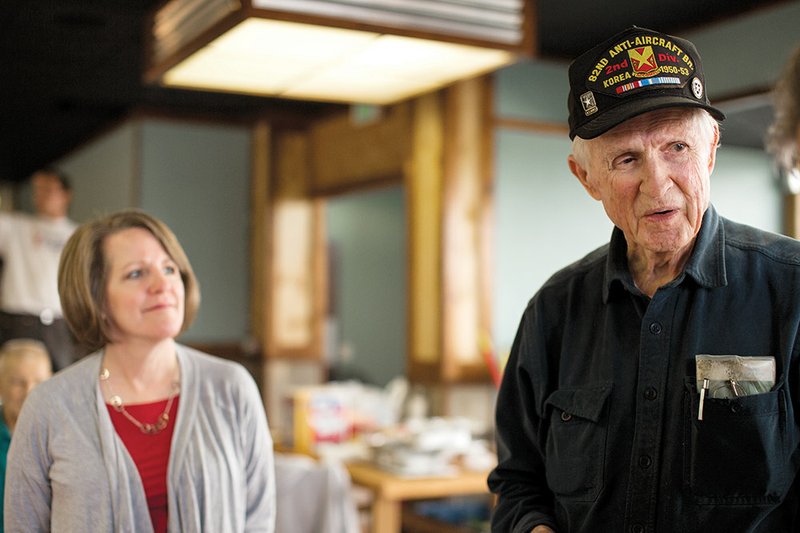CONWAY — The Korean War, which began June 25, 1950, and ended July 27, 1953, is often referred to as “the forgotten war,” partly because of the lack of public attention. But for three veterans in Conway, the Korean War has not been forgotten.
Melvin Bailey, William Harry Midgett and Harold Starr will be among the veterans who will attend a Veterans Day celebration at 9 a.m. Monday at Julie’s Sweet Shop in the Conway Towne Centre. They share a little bit of their stories with today’s readers.
Melvin Bailey
Bailey, 85, grew up in Little Rock and has lived in Conway for 19 years.
He was drafted into the Army in 1951 and served until October 1952.
“I was part of the 2nd Infantry Division and saw combat at Bloody Ridge in September and at Heartbreak Ridge in October,” he said. “I was in nine major campaigns while I was in Korea. Technically, that war has never ended.”
After his discharge from the Army, Bailey built homes for 14 years. He then began a 20-year career with the U.S. Army Corps of Engineers, serving in Branson, Mo., as the chief of construction at Table Rock Dam and Lake.
“I now live alone,” he said. “I lost my wife six years ago.”
He has two children and four grandchildren.
Bailey said there were 800 men in his unit in Korea, and 95 died as prisoners of war in North Korea.
“Their bodies are still there in unmarked graves,” he said. “Over 100 were captured when the Chinese came into the war.
“The North Koreans let them keep their dog tags, but when they died, they buried them with their dog tags in their mouths.
“Someday, with the use of metal detectors, we will bring them home,” he said with conviction.
Bailey often talks to civic groups and schools about his experiences in the Korean War.
William Harry Midgett
Midgett, 81, grew up in Greene County and moved to Conway in August to be near his daughter, Tracy Tidwell.
He was drafted in 1954 at the age of 23 and served two years of active duty in the military police, but he never saw combat duty. He then became a U.S. Army Reserve active member and served six more years.
“I dropped out then, for 13 years, joined the Arkansas National Guard in 1977 and served 17 years,” he explained.
He retired at age 60 as a staff sergeant with the 875th Engineer Battalion in Jonesboro.
“I was lucky,” he said. “By the time I went in, I was married, and my wife was expecting a baby. I was stationed at Fort Gordon, Ga. My unit was combat-ready, but we were never called.”
Midgett said he had trained for duty at the Tomb of the Unknown Soldier at Arlington National Cemetery but was never called for that duty, either.
“The Army gave me a pretty good career,” Midgett said. “I’m glad I stayed with it.”
Midgett said he only finished the eighth grade in school.
“When I was at Fort Gordon, they tried to get me to take the GED, but I didn’t,” he said. “After I joined the Guard, I did take it, when I was 45. I didn’t study for even one hour. I passed. I guess I had learned something over the years.”
Midgett talked about being drafted.
“I was drafted right off the farm. I farmed rice at that time,” he said. “In the early ’50s, you could farm all you could sow. So I was deferred from military service. They changed that rule, and that was when I was drafted.”
Midgett and his wife raised their three children on that farm in Delaplaine in Greene County.
Harold Starr
Starr, 81, grew up in Little Rock and moved to Conway about a year ago. He was drafted
into the Army at age 21 and served 16 weeks in boot camp at Camp Roberts, Calif., before he shipped out for Korea.
Starr, who was a private first class in K Co., 15th Infantry Regiment, 3rd Division, took part in what he calls “the biggest battle” of the war, the Battle of Outpost Harry. He said he fired the first shot of the battle, which would last “eight days and nights.”
The battle was between U.S. forces and the Koreans, who were joined by the Chinese and involved a stretch of land known as the Iron Triangle. It was 60 miles south of Seoul and was the most direct route to the South Korean capital. If the Koreans and Chinese could take the Iron Triangle, they would control the whole area.
“They could not take it,” Starr said. “The trenches were 5 and 6 feet deep but were level ground because of the dead bodies that filled them.”
Starr was wounded in the battle on June 10, 1953, and sent to Japan where he was hospitalized for six months. The war ended on July 27, 1953.
Starr said the American troops were ordered to “hold at all costs, maintain your position or die trying, with no possibility of retreat.”
He is part of a PBS documentary, Hold at All Costs. A trailer for the film can be found on the Internet. The documentary first aired in 2010.
After the war, Starr worked as a contractor, building houses. He now lives with his son in Conway; another son and Starr’s wife are deceased.
Starr said he has led a “pretty good life, with ups and downs.”
